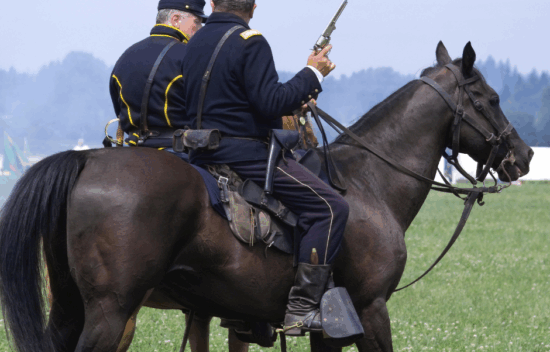
Battles of the Civil War Lesson Plan
Guiding Questions
- What were the major turning points and events of the Civil War?
- How did the war transform the nation socially, economically, and politically?
Objectives
- Students will investigate major battles of the Civil War.
- Students will match descriptions of battles to historical art images representing them.
- Students will deduce the significance and impact of major battles.
Student Resources:
Teacher Resources:
Facilitation Notes
- This lesson is designed to be used in tandem with, or in place of, our Local Civil War Battle Research lesson plan. Use your time constraints and state standards to assess which is best for your situation.
- Titles and citations for the images in the Battles of the Civil War Primary Source Set:
- Image 1: Kurz and Allison, Siege of Vicksburg, c. 1888, chromolithograph, Library of Congress
- Image 2: Kurz and Allison, The Battle of Gettysburg, August 14, 1884, chromolithograph, Library of Congress
- Image 3: Kurz and Allison, Battle of Antietam, 1888, color lithograph, Library of Congress
- Image 4: Currier and Ives, Bombardment of Fort Sumter, c. 1861, lithograph, Library of Congress
Anticipate
- Before class begins, prepare the student resources. You can print and prepare color copies of the map puzzle for repeat student use, or print individual paper copies for each student.
- When class begins, Group students into teams of 3-4 students.
Scaffolding note: Mixed ability groups work well for this activity.
- Provide students with pieces of the map showing key Civil War battle locations. Have them work in small groups to assemble the map and predict which battles might have been significant based on location (e.g., near rivers, capitals).
Scaffolding note: This activity can also be completed independently using paper copies of the map puzzle.
Engage
- Glossary term(s): battle, civil war, predict, significant
- Using the same student groups, distribute to each group a copy of the primary source set for this lesson. The resources contain four historical art pieces and four short essays.
- Assign students an amount of time, 10-15 minutes is a good place to start.
- Ask students to read the essays about Civil War battles and match each essay to an art piece that depicts the battle. The essays and art pieces will depict:
- The Battle of Fort Sumter
- The Battle of Antietam
- The Battle of Gettysburg
- The Battle of Vicksburg
Explore
- Once students have investigated the battles by reading the sources and making connections to the art, allow them to choose one of the four battles, or assign each student a battle.
- Using the same sources, students will play the Explanation Game to consider the sources more deeply with the other students who chose the same battle.
- Some groups may be larger or smaller than others. This is fine as long as all four battle groups have at least two students.
The Explanation Game
- Begin by placing copies of the essay and historical art image with each group of students. There will be four groups, one for each battle.
- Ask students to begin by considering the art. The first person (this might be the teacher) points out an interesting feature of the art piece: “I notice that…. That’s interesting. Why is it that way?” or “Why is this battle depicted that way?” (or some similar “why” question).
- The other people in the group try to answer the question or at least to propose possible explanations and reasons based in the essay. As these students share their ideas, the person asking the original question follows up by asking, “What makes you think so?”
- The group works together to build explanations based on their understanding of the essay, the art, and their prior knowledge and reasoning to provide an answer.
- Ask students to record their conversation as a chart with four columns representing the key structures of the conversation: 1) the Observation that is initially made, 2) the Question that comes out of that observation, 3) the various Explanations/Hypotheses that the rest of group puts forth, 4) the Reasons/Justifications that are given in support of the explanations.
Scaffolding note:It may help to assign the role of recorder for this task to a member of the group.
- Set a timer for 10-15 minutes. Students should be able to go through the thinking routine for 3-4 observations in that time.
Assess & Reflect
Written Response- Thesis
- Ask students to use the information they have learned from the map, battles matching, and Explanation Game to craft a thesis.
- Thesis Prompt: Choose a Battle from the Civil War: Sumter, Antietam, Vicksburg, or Gettysburg. Why is this battle considered a significant battle of the American Civil War?
- Students can choose to use the battle they focused on in the Explanation Game or choose another battle.
- Encourage students to use the sources to support their statement.
Scaffolding note: To support student writing, use the BRI mini-lesson on writing a thesis statement and/or the BRI thesis graphic organizer.
Extend
- Allow students to investigate an additional Civil War battle using our Local Battle Activity Lesson Plan. The lesson can be used with any battle, so students can investigate a battle with significance in your local community, a battle they need to learn to address state standards, or a battle they are particularly interested in.